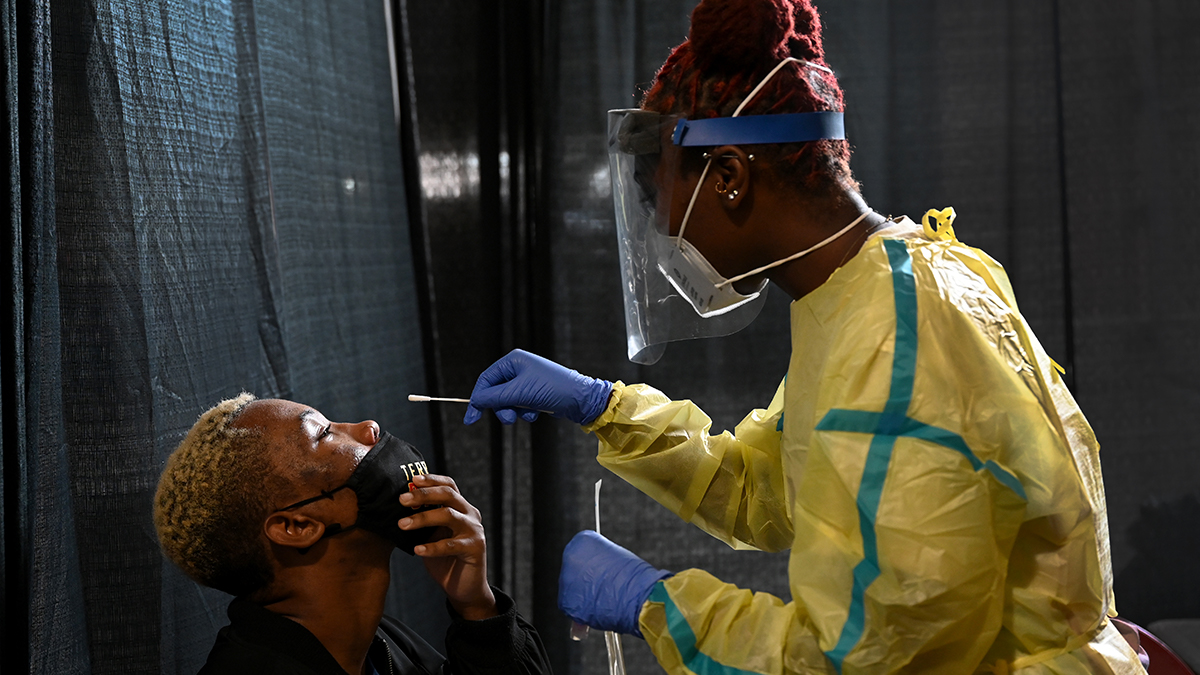The number of coronavirus cases diagnosed daily in D.C., Maryland and Virginia has fallen to the lowest point in more than five weeks.
After each area loosened coronavirus restrictions at the end of June, there was a surge of infections that lasted through most of July.
But the trend line shows that the region has had success in reversing that troubling course.
Prince George's County also hit a major milestone: Finally hitting the state's positivity goal of below 5%. For weeks during the spring, Prince George's suffered the worst coronavirus outbreak in the state. It was the last county to reach the positivity goal.
On Thursday, Montgomery County, Maryland, will resume COVID-19 testing via kits it got from the state of Maryland. Testing there was halted last week when the state health department ordered it to stop using saliva tests from the Rockville lab, AdvaGenix.
Here's information on where to get tested in Montgomery County.
We're making it easier for you to find stories that matter with our new newsletter — The 4Front. Sign up here and get news that is important for you to your inbox.
What the Data Shows
The data trends show fewer people are catching coronavirus because the seven-day average of new cases continues to slide.
Those numbers have dipped dramatically from last Thursday: Averages declined in D.C. from 72 to 55; in Maryland from 736 to 581 and in Virginia from 1,026 to 837.
D.C. is also reporting progress in successfully quarantining possible coronavirus patients. On Thursday, 7% of new cases were from people already quarantined because of previous contact with a confirmed patient.
It's far short of D.C.'s goal, which is to have 60% of cases diagnosed among people already quarantined. But the number is trending upward.
In Prince George's County, testing hit a significant milestone Thursday. The proportion of coronavirus tests coming back positive fell to 4.93%.
The World Health Organization suggests an area record at least 14 days with a positivity rate below 5% before proceeding with reopening, Maryland Gov. Larry Hogan's office pointed out in a release.
The map below shows the number of coronavirus cases diagnosed per 1,000 residents.
Coronavirus Cases in DC, Maryland and Virginia
COVID-19 cases by population in D.C. and by county in Maryland and Virginia
Source: DC, MD and VA Health Departments
Credit: Anisa Holmes / NBC Washington
Local Coronavirus Headlines
- Special needs students are among the first groups who should get in-person instruction, Fairfax County school officials say. Read more.
- Montgomery County officials said in an update Wednesday that testing will resume at county sites using test kits from the state. Testing was suspended last week after the state health department ordered the county stop using saliva tests from a Rockville lab. Read more.
- The federal government has started sending new COVID-19 testing systems to nursing homes around the country in hopes that the rapid results provided by antigen tests will slow the spread of the virus. Long-term care facilities certainly welcome that assistance, but some have major concerns about those tests. Get the News4 I-Team report.
- Most people recently diagnosed with the coronavirus in D.C. had no known contact with someone who had the virus and did not attend events or travel, new data from the city says. Read more.
- Montgomery County residents who have been hit financially hard by the coronavirus pandemic can apply for short-term rental assistance. The application is open through Aug. 31.
- Metrorail service has increased to the highest levels since the pandemic began – and more stations are opening soon. Read more.
- Virginia Gov. Ralph Northam unveiled a plan for limited new spending on blocking evictions, boosting high-speed internet access and more. Read about the plan.
Reopening Tracker
- Private and parochial schools in Maryland can choose when to reopen after a back-and-forth between county health officials and the governor. Read more.
- Prince George's County is revising its phase two reopening executive order due to an uptick in coronavirus cases, according to the county executive's office.
- Virginia entered phase three reopening on July 1, loosening restrictions on restaurants, stores, gyms and pools. Northam said more restrictions could be implemented if cases continue to grow.
- Prince George's County entered full phase two on June 23, allowing the MGM Casino and gyms to reopen.
- D.C. entered phase two on June 22, allowing indoor dining, gyms, libraries and houses of worship to reopen with restrictions.
- Montgomery County entered phase two on June 19, reopening with restrictions gyms, houses of worship, indoor dining and retail.
- Maryland entered phase two of reopening on June 10, permitting indoor dining, outdoor pools and outside amusements to reopen.
How to Stay Safe
There are ways to lower your risk of catching coronavirus. Here are guidelines from the CDC:
- Wear a snug-fitting mask that covers your nose and mouth.
- Avoid being indoors with people who are not members of your household. The more people you are in contact with, the more likely you are to be exposed to COVID-19. If you are indoors with people you don’t live with, stay at least six feet apart and keep your mask on.
- Wash your hands often, especially after you have been in a public place.
Sophia Barnes, Andrea Swalec and Anisa Holmes contributed to this report



